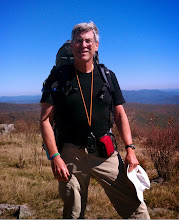I've been tired lately, and slept in both days until 7:45 - almost unheard of for me. So I didn't get in a dawn hike, as is my custom when I am down that way. But I did take a break from the near perfect beach weather Sunday to take a three mile hike in Back Bay National Wildlife Refuge. I walked along the little nature trail system for a while, marveling at all of the warblers coming through on their perilous migration back to Central America for the winter. I saw several different types, all hard to identify this time of year for me. I am pretty sure one of the dominant ones was the Myrtle (yellow rumped) warbler. I saw many dozens of warblers, and stopped often to try to watch them in my binoculars as they flitted around. I also saw a deer, just yards from the path, which was amazing since hunting season here ended just the day before. Somehow, they know, but when I took one step off the path to try to get close enough for a photo, she bounded into the woods. From there, I walked down the East Dyke Road for a bit, knowing that come tomorrow, it will be closed for six months to allow the waterfowl - especially the tundra swans - their winter break. Along the way, I spotted a raft of some kind of duck in the distance, saw a large turtle which dove in alarm (as if I were going to jump in and grab him), and got a good view of a harrier as it swooped over the marsh.
-
Here are a few photos:
Cattails along side the path:

Knarled tree trunk:

A peaceful freshwater pond along the path. I have frequently seen American bittern in this pond, but not today:

This bald cypress is a conifer, but loses its needles for the winter. Right now, they have turned a beautifully coppery or bronze color:

This tree looked like it was covered in white flowers, but they are some type of airborne seed, waiting for just the right wind to come along:

I did a SPOT check-in test from this point:
Then I took a picture from the East Dyke Road, which runs as a foot and bike path to False Cape State Park:



 And here is the track of the circuit, mapped in DeLorme's Topo USA 9.0:
And here is the track of the circuit, mapped in DeLorme's Topo USA 9.0:

































